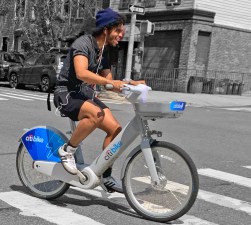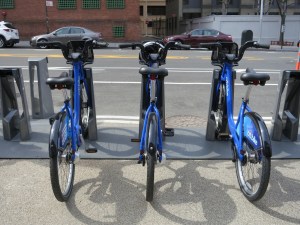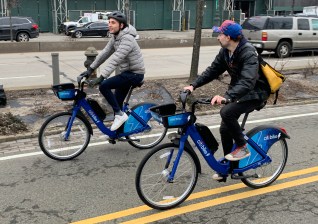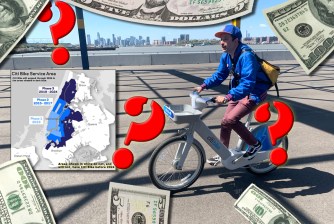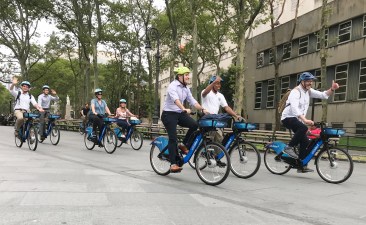ASKING FOR A FRIEND: Is Citi Bike Being Held Hostage By DOT Fear of Inconveniencing Drivers?
The share service needs to add thousands of docks in Manhattan, but the DOT is not keeping up with its requests.
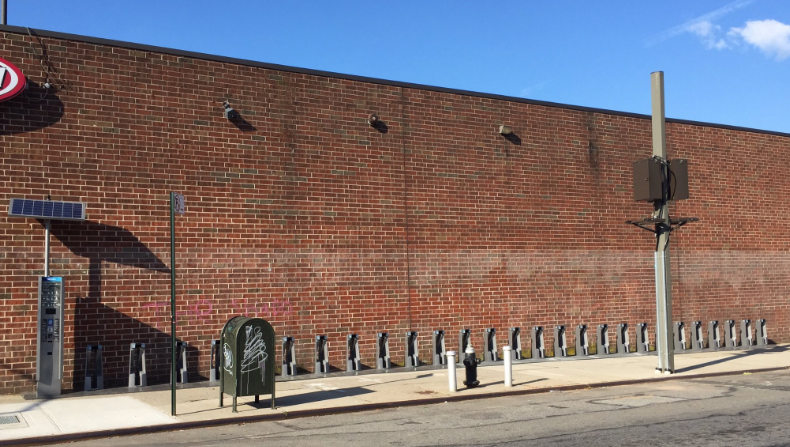
They want to beat parking spaces into bike shares.
Citi Bike says it needs to add thousands of docks within its existing Manhattan service area to handle the ongoing bike boom, but so far, the Department of Transportation has not kept up with the Lyft-owned bike company’s requests — and millions of rides are not happening as a result.
In a bombshell statement that dropped extremely quietly last week, Citi Bike announced that it needs the DOT to provide it with sites for an immediate Lyft-funded infusion of docks and bikes because the system is under “added stress [in] its original service area, which serves a disproportionate number of the total rides.”
In other words, too many people are either showing up at docks that are empty or trying to return bikes to full racks. Even as it is breaking its own records, Citi Bike estimates that it lost 4 million rides in 2021 because customers are getting frustrated. The company cited the ridership increases as well as “unpredictable commuting patterns as a result of the pandemic.
“An unbalanced system results in riders finding empty or full docks during periods of peak demand,” a problem that cannot be totally mitigated through rebalancing or Bike Angels, the company said.
“The most efficient and effective long-term solution is to densify the station network through infill,” the statement said. “Balancing issues caused by insufficient infill density in the original Citi Bike service area leads to 4 million rides being ‘lost’ per year” — and that’s not even including bike rides that are induced as a result of new infrastructure just showing up.
“Citi Bike is getting crushed under its own success,” added company spokesman Jordan Levine. “The city is in a situation right now where there is more traffic and people using cars, but also record numbers of Citi Bike users. So for our system to be able to provide an alternative form of transportation, we need more docks and bikes. So as the city allocates curb space, we are asking for a fractional amount so the system can function and thrive.
“We are just worried that we will not be able to keep up,” Levine added. “Record numbers of people are turning to bikes, thanks to our docks and the city’s bike lanes. But to serve those people and encourage more riders, we need to do infill.”
Curb space is at a real premium at the moment, with the city providing curbside space to an estimated 10,000 restaurants to help that industry “function and thrive” through the pandemic. The de Blasio administration has said that the giveaway of public space was warranted to keep the restaurant industry, and its jobs, alive, but however it was justified, the city is under fire for reallocating public space to help struggling businesses when advocates for other public purposes — such as the creation of new green space, the removal of garbage from the sidewalks and into containers, or simply providing car-free space for kids and seniors — are also calling for the curb to be reallocated.
And, of course, the city has already been sued by West Village and Chelsea residents who complain that restaurant sheds are noisy and have taken away “their” parking.
Citi Bike docks currently occupy just .5 percent of curb space. But siting those docks has proven to be a perennial challenge to the DOT, which seeks community board input for every single location. As a result, many are sited on sidewalks rather than in curbside spots, which has the double-edged problem of discriminating against pedestrians while also doing nothing to discourage car ownership.
In the email sent to reporters, Lyft also included a map of the zones where the Citi Bike system is experiencing the greatest need for infill docks:

Infill neighborhoods were identified through a DOT-led data analysis that evaluated station ridership in relation to current docking capacity, Citi Bike said in its statement. The DOT has provided Lyft with 50 locations — enough for 2,000 docks — which will start showing up on the Citi Bike map by the end of this month, Levine said.
But that still leaves another 150 stations needed to be sited — at a time when DOT is under pressure regarding how it allocates public space. To help insulate DOT from public outcry over “parking” spaces, Lyft reminded that the main infill area of Manhattan below 59th Street is a majority car-free area. And the company touted its efficient use of public space: In the space of a single “parking” space, the average Citi Bike station accommodates approximately 27 bike trips per day. By comparison, a single car makes an average of 2.5 trips per day — and is stationary 98 percent of the time. That means that Citi Bike is a “nearly 11-times more productive use of space.”
Lyft will pay for the hardware. It just needs the city to tell it where to install it. For its part, DOT spokesman Seth Stein told Streetsblog that the agency will “continue working … to identify locations for new docks,” but his statement fell short of the urgency being expressed by Lyft.
“We agree that it is important to continue supporting Citi Bike expansion as it grows even more popular,” Stein said. “Citi Bike is key to promoting cycling in our city, as well as a sustainable form of transportation that helps get New Yorkers out of their cars.”
The move for infill also comes as the DOT is citing 5,000 docks to expand the Citi Bike footprint deeper into Queens and Brooklyn.
To understand the place that Citi Bike has in the life of New York (or, well, parts of New York!), it’s important to remember that Citi Bike launched in 2013 with just 6,000 bikes and 312 stations. Now, it has more than 23,000 bikes and more than 1,500 stations (roughly 46,000 docks). New Yorkers and visitors have taken more than 136 million rides on Citi Bike since the system launched, and that includes more than 22 million this year, the company said. The system set its ridership record in 2019, then broke it in the firsts 10 months of this year, with a 30-percent increase in ridership during the citywide bike boom. The company claims that it has had more than 1.15 million unique riders so far this year.
There have obviously been complaints about Citi Bike docks being empty or full at certain hours and in certain places. But the other persistent complaint about Citi Bike has been its slow expansion deeper into parts of the city that could also benefit from unlimited 45-minute rides for a simple $179 annual membership — a fee that drops to $60 per year for residents of Housing Authority properties and for recipients of food benefits. Hundreds of thousands of people meeting that requirement currently live in the Citi Bike zone, but hundreds of thousands more are currently not able to use Citi Bike because docks have not reached many areas of the city where car ownership is limited: all of the Bronx east of Hunts Point; Sunnyside, Jackson Heights, Maspeth and Elmhurst in Queens; parts of Bedford-Stuyvesant, Crown Heights, Flatbush, Midwood and Borough Park in Brooklyn; and all of Staten Island, which is suffering from the DOT’s ongoing failure to find a bike-share operator. (Stein said that many of the above-listed areas are, indeed, part of the expansion zone for 2022.)
To speed the expansion, most of the mayoral candidates promised to provide city subsidies to the Lyft-owned company, which currently only benefits from its ability to use public space for docks (the company has to even pay for parking in areas where the city would normally charge via parking meters).
Brooklyn Borough President — and likely mayor-elect as of today — Eric Adams said he would use city money to make sure New York is “expanding Citi Bike well beyond more affluent communities.”
